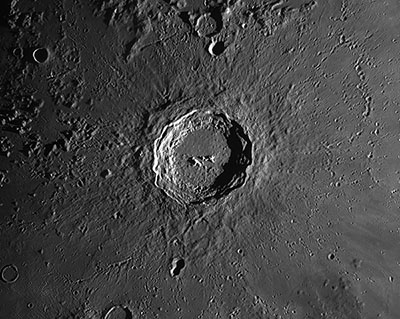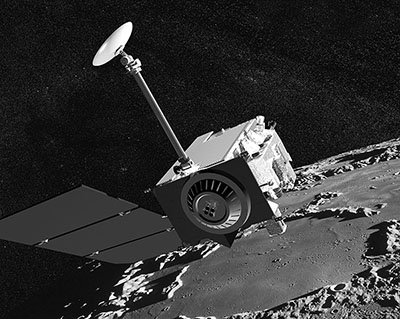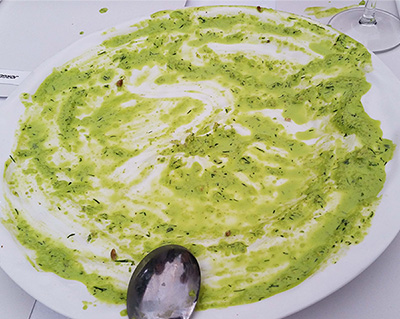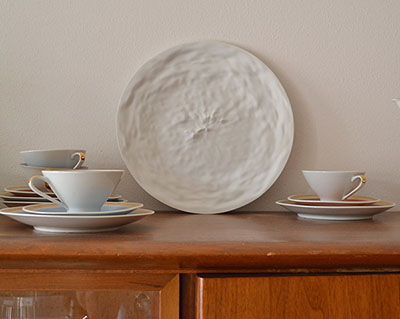Copernicus
plate

The Artwork
The Copernicus plate is an exact, scaled-down replica of the Copernicus crater's surface on the moon. The plate's production was made possible by a NASA satellite sent into space in 2009, which, among other tasks, makes 3D scans of the moon's surface to generate precise models.
Copernicus is made out of porcelain at the Reichenbach Porzellanmanufaktur in Thuringia, Germany. The porcelain plates combine traditional handcraft, high technology and the culture of dining with the exploration of the unknown, in this case the moon — the boundary to our endeavor to explore beyond our own planet.
No matter how far the original crater is, we hope that the plate turns the moon into a meeting place, a place in which, over the course of an evening, stories - both factual and fictional - speculation, faith and doubt, hope and myth can be spun into a higher unit, or simply melt away into the late night.




Banquet #1
During lunar eclipse on Monday August 7, 2017, L+S hosted an experimental dinner in Oslo together with Martin Braathen (architect) and Lars Petter Hagen (composer). The dinner served on on Copernicus plates was accompanied by lectures by Stephanie Werner (researcher / professor, Institute for Geology UIO), Per Ditlef Fredriksen (university researcher / professor, Institute for Archeology, UIO) and Olof Olsson (performance artist based in Copenhagen).

Menu #1
Finger food:
— Jerky:
Dried reindeer meat, tørrfisk (dried cod)
Origin: Air shuttle Discovery, December 2006. An homage to Norwegian-Swedish astronaut Christer Fuglesang who was not allowed to bring reindeer jerky with him on board the space shuttle Discovery. Eating Rudolph so soon before Christmas, was considered inappropriate by NASA. He had to go with moose jerky instead. Today, we fulfil his wish.
Dishes:
— 1.Tarator:
Cold soup with walnuts, garlic, yoghurt, dill, lemon and cucumber. Bread. Origin: Interkosmos space program, Bulgaria 1973. Institute of Cryobiology and Lyophilization developed freeze-dried space versions of traditional Bulgarian dishes.
Instruction: Group work: excavate the crater with bread or spoons.
— 2. Shrimp cocktail:
Langoustines, thousand island moon dust (secret recipe of NASA), mayonnaise (egg, oil, lemon, mustard). Origin: NASA, Skylab space station 1974. After protests by astronauts experiencing problems with rehydrating food in space, especially that of collecting floating crumbs, NASA developed a series of frozen foods, including the shrimp cocktail, which became a favourite up until the 1990s.
Instruction: Turn your plates up-side down. Powder plate from above with thousand island gold dust. Place a dollop of mayo in suitable place. Peel langoustine and place accordingly. Eat or discard. Wipe your plate with a sheet of paper.
— 3. Borscht:
Pieces of hot smoked mackerel with dill. Leeks, potato, celery, beets, fish stock. Sour cream with horseradish. Origin: US-USSR Apollo-Soyuz Test Project, food developed in Estonia 1975. Among the astronauts of the Soviet Union, borscht on tube became a staple through the first three decades of space food.
Instruction: Again, quickly wipe, then turn you plates. Pile three pieces of mackerel together in a flat area of the plate. Pour over borscht, not covering the mountain tops. Dress with crème fraiche. Eat or discard. Refill borscht until you are full or mug is empty.
— 4. Cheese:
Goat milk, dried blueberries and figs, honey.
Instruction: The moon is a cheese. Consume it.
— 5. Petit four:
Mars, Milky way, Galaxy. Origin: Inner and outer space
Instruction: For a minute, contemplate the Copernicus crater within the context of outer space. Then, take a chocolate bar and eat.

Banquet #2
Coming soon.
About
L+S are Lutz-Rainer Müller (*1977) and Stian Ådlandsvik (*1981), a Norwegian-German artist duo. Their main interest is art in relation to space and the public sphere. Their work is materially and strategically diverse, and often leads to playful and unexpected results. They have worked together since 2006, and both of them have a degree from the National Academy of Fine Arts in Oslo. Ådlandsvik has also studied at the Hochschule für Bildende Künste in Hamburg, while Müller has studied at the Art Academy in Bergen and holds a diploma from the Muthesius Art School in Kiel.
The production is supported and produced by URO/KORO:
Thank you NASA for 3D scanning the Moon and for making the models available for use to the public. This project would not have been possible without your openness.
Contact
L+S AS, Sverdrupsgate 5, 0559 Oslo, Norway
Lutz Rainer Müller
lutz@l-plus-s.com
Stian Ådlandsvik
stian@l-plus-s.com



